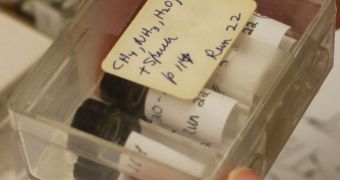According to a new iteration of an old experiment, it could be that the earliest life-forms that developed here on Earth smelled very, very bad. Experts came to this conclusion after analyzing the residues left behind by a study carried out by renowned expert Dr. Stanley Miller in the 1950s.
In the groundbreaking investigations the researcher conducted, he used hydrogen sulfide (H2S) gas to emulate the atmosphere of early Earth. This was innovative in its day, as no one had ever done this before him.
This was also Miller's only experiment that incorporated this chemical, explains Georgia Institute of Technology (Georgia Tech) expert Eric Parker. He adds that H2S is the substance that gives rotten eggs their characteristic smell.
Parker is also the lead author of a new paper detailing the recent investigation. The work was published in the March 21 online issue of the esteemed journal Proceedings of the National Academy of Sciences.
“Much to our surprise, the yield of amino acids from Miller’s hydrogen sulfide experiment is a lot richer than that from any other experiment he had ever conducted,” explains professor Jeffrey Bada.
The expert, who was one of Miller's graduate students, is based at the University of California in San Diego (UCSD) Scripps Institution of Oceanography (SIO). He is also the corresponding author of the newly-published paper.
Bada discovered a few sample vials that originated in Miller's experiment back in 2007, after the great scientist's death. He then proceeded to analyze the samples with modern technology, and discovered 22 amino-acids, of which 10 had never been identified in such experiments before.
“Stanley mentioned to several of us that he hated working with hydrogen sulfide because it smelled so bad and tended to make him sick,” Bada says of Miller's approach.
“Given that some of the compounds he made in the experiment smell pretty bad, this experiment may be the basis for his reluctance to deal with H2S in experiments,” he goes on to say.
“The sulfur-containing amino acids we found include significant biological ones like methionine, the product of the 'start codon' in the genetic code, which tells a cell's machinery to begin translating the design for a protein,” says Dr. H. James Cleaves.
The expert, who is based at the Carnegie Institution of Washington, performed some of the analysis in the PNAS paper together with colleagues at Analytical Astrobiology.
According to Parker, the new findings could provide additional insight into the role that ancient volcanic eruptions played in the formation of early organic compounds on Earth. Volcanoes release atmospheric H2S naturally as they explode.
“The results indicate that volcanic areas on the primitive Earth may have been responsible for the localized production of large quantities and varieties of prebiotic compounds on ancient Earth,” he concludes, quoted by NASA.

 14 DAY TRIAL //
14 DAY TRIAL //